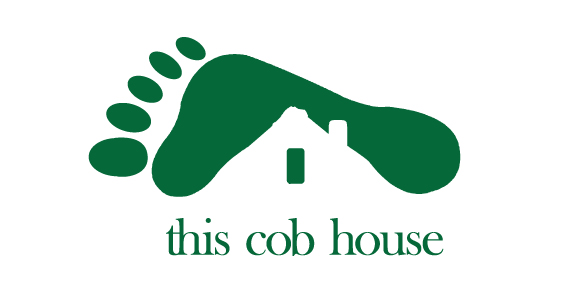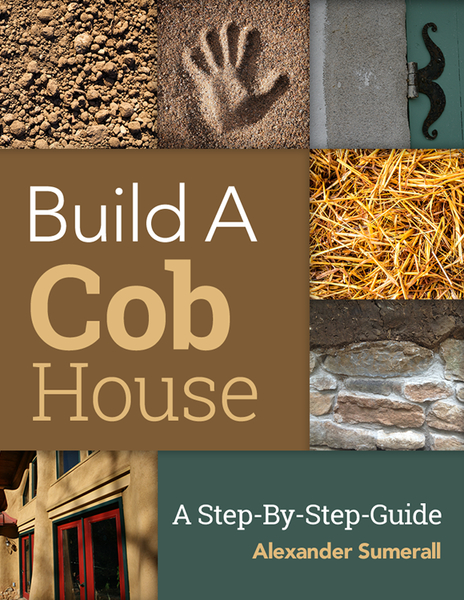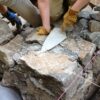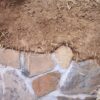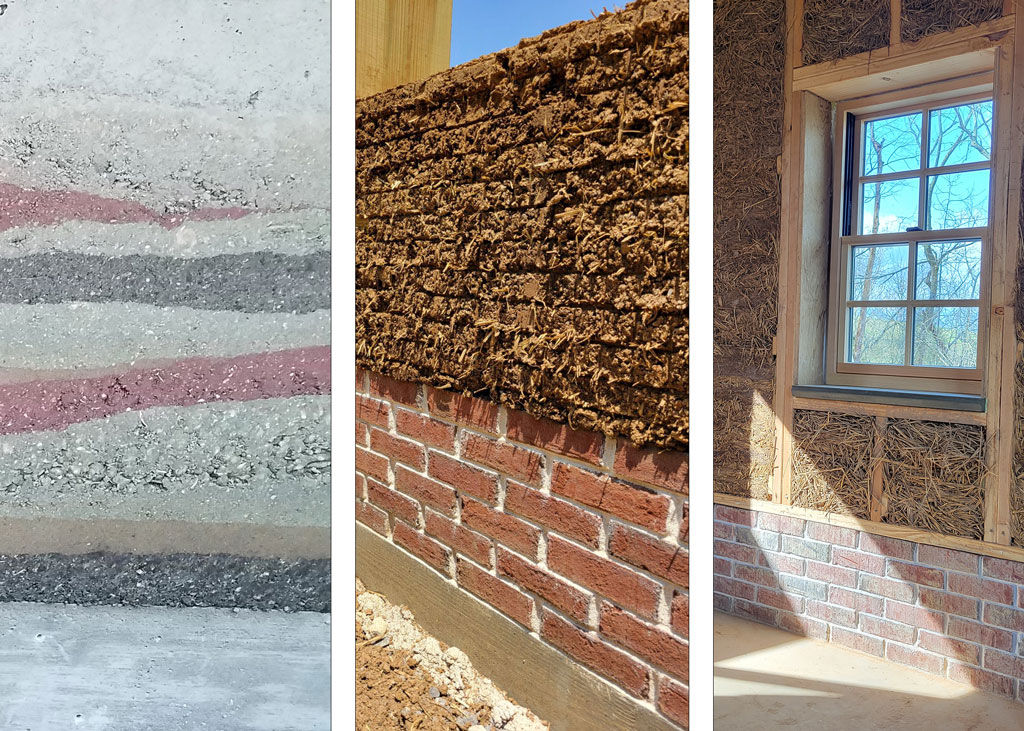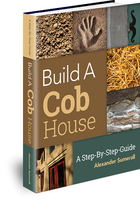How to Make Cob
There are several different methods for mixing cob. In this book, I will instruct you on how to mix cob manually and mechanically. I always recommend that people learn how to mix cob manually first. It gives you a better feel for the material and you will quickly understand what to look for when you are mixing cob with machinery.
Tarp Method
One of the most common and regularly-practiced techniques for manual cob mixing is called the tarp method of cob mixing. This is one of the most basic and most labor intensive ways of making cob. You can create very consistent, well-mixed batches of cob using this method, but you will also burn the most human energy and time as well.
The tarp method can be done by yourself or with one other person. Whether you do it solo or with a partner is up to personal preference. You will need a large tarp and a few buckets for soil and aggregate. Always use buckets of the same size, whether they are 5 gallon or 3 gallon buckets. Fill them up flush to the top of the rim. You want to be using the same sized containers so you have a standardization for measuring material volumes.
1. Organize all of your materials and tools close to your building site. Soil, aggregate, straw, water, tarp, and buckets.
2. Lay out your tarp on a flat space. This is where you’ll be mixing. Since you will likely be mixing with bare feet, make sure that any sticks or rocks are out from underneath the tarp since these will hurt to step on.
3. Put your dry ingredients (subsoil and aggregate) in the middle of your tarp in a pile in accordance with the cob ratio that you have decided to use.
Here are some common ratios to start testing with:
Sand 1: Soil 1 (Starting with an equal balance is a good place to begin.)
Sand 2: Soil 1 (If your cob cracks a lot, add more sand.)
Sand 1: Soil 2 (If your cob is too sandy and brittle, add more soil.)
4. Now you will mix the dry materials together on the tarp. Grab two corners of the tarp and walk forward to the center of the mix, folding the tarp in half. The dry materials should be together in the center of the tarp. Put the tarp back in its starting position and lay it out flat on the ground again. Go to the other end of the tarp and repeat the process of turning the dry materials over. Do this 4 to 5 times or until the dry materials are mixed thoroughly together. Put the dry ingredients back to the center and lay the tarp flat again.
5. Pile up your dry ingredients in the middle of your tarp and spray some water over the top of it. Be careful not to add too much water as you mix. It’s always best to add too little water than too much! It’s much easier to add little bits of water as you go than to try and fix adding too much from the start. You will have to experiment to determine how much water you will need in your mix. You’ll figure out how much water to add through experience making cob. Remember not to add too much water though. It might be easier to mix, but it will not hold up as well when you start building and it will slump. Overly wet cob is also more susceptible to cracking as it dries. However, if you do add too much water you can either leave the batch to dry out in the sun, add more straw to soak up some excess water, or add more dry ingredients.
6. Begin mixing by using your feet to smear the materials together with the water. You can do this by yourself or with others depending on how much room there is on the tarp. Twist your heels into the mixture for the best mixing. The goal is to make sure that all the dry materials are mixed together well with the water and that all the clay and sand are smeared together thoroughly.
7. Once the mixture has been stopped flat and spread out, you will pull the corners of the tarp to fold the mix on top of itself again. Stomp the mix again, and repeat this as many times as it takes to get the right consistency. You can continue to add some water to your mix as you go. Just add little bits at a time though. Eventually your whole mix should be forming into what some people call a “burrito” shape when you roll the tarp back and forth. Once it takes this shape you have a good indicator that your cob mix is ready for adding straw.
8. Take some handfuls of straw and sprinkle it over the cob mixture. Again, start to stomp the cob mixture until all of the straw has been covered and smeared with cob. Use the tarp to gather the mix up and turn it over again. Stomp some more until flat. Add more straw and repeat the process as needed. There is no exact amount of straw to use. You will need to decide how much straw you want in your cob. Some people like straw-heavy cob, some like less straw in their cob. Continue repeating the mixing process until all of the straw is thoroughly distributed and mixed into the cob. You’ve just made cob!
Mortar Mixer
My preferred machine for mixing cob is a mortar mixer. The first thing to know about the mortar mixer is to not get it mixed up with a concrete mixer. They are very different machines. A concrete mixer will only tumble the materials round and round. This works for mixing very wet material such as concrete and some earthen plasters. A concrete mixer will not mix cob. On the other hand, a mortar mixer has paddles inside that actually smear and mix the material together, much like how you would do it with foot mixing on a tarp.
The mortar mixer is at least ten times faster than mixing cob by foot and it will save you a tremendous amount of human energy and time. I recommend the mortar mixer for almost any size project, and for groups of workers ranging from one to twenty five people. A mortar mixer is probably all you will ever need as far as cob mixing machinery goes. If you have extra labor and want to mix more cob, use two mortar mixers. There are larger machines that you can use to mix cob, which I’ll touch on here soon, but you likely will never need to use these other options.
Mixing cob with a mortar mixer is quite easy, and follows the same concepts as mixing cob with the tarp. Once the machine is running, add your soil, aggregate, and water. The machine will mix it up within a few minutes. You will notice the cob “clumping” together on the mixing paddles. At this point, sprinkle your straw into the mixer as the paddles continue to spin. You may need to spray in bits of water throughout the mixing process. Once everything is thoroughly mixed together, dump the material from the mixer into a wheelbarrow and take it to the building site.
Mortar mixers are reasonably easy to find for rental. They range in cost from $150 to $400 per week depending on the size of the mixer and where you rent from. You can purchase a new mortar mixer usually somewhere in the range of $3,000 to $4,500. Used mixers can be bought at much cheaper prices too.
When you rent or purchase a new mortar mixer, always check to make sure that it’s in good shape. All the pins and safety mechanisms should be solid and in good working order. There should not be any bent or loose pieces on any of the metal framing. Most of the mechanical malfunctions you will encounter with a mortar mixer are a result of worn out belts and clogged air filters, which are easily replaced.
Safety Note: When operating a mortar mixer, never put your hands inside the mixing bucket. Whether the paddles are on or switched off. As long as the motor is running, never put your hands or arms inside the mixing bucket. If you need to clean or unclog the bucket, always turn off the engine entirely first. When sprinkling straw into the mixing bucket, keep your hands at least a foot above the mixing paddles for optimal safety. There is no need to put the straw in as close to the bucket as possible.
Tractor or Skid-Steer
When we talk about using a tractor or skid-steer, we understand that it has a front-end loader with a bucket equipped to it. A few things to note about using these machines to mix cob:
- You will need at least a 20 foot by 20 foot concrete mixing pad to mix the cob on.
- Do not mix without a mixing pad unless you have no choice. You will pick up too much surface material and dirty-up your cob mix without a clean mixing pad.
- Using one of these machines makes very large batches of cob per mix. The size of your machine and its bucket will determine the size of the batch. A large batch of cob can sit still and last for several days (depending on the environmental conditions), but it’s best if you can use the newly created material on the same day or the next morning. This requires a team.
- You can make one large batch of tractor cob in one hour that would take a group of 10 people one or two full days to make by foot. Machines are a tremendous time saver.
- You can more easily transport the mixed cob from the mixing station to the building site. You can sometimes even drop the fresh cob right onto the wall being built. Then the workers only need to form it into place. This can save a lot of time and labor this way.
I only recommend mixing with a tractor or skid-steer if you are building a large cob house and have a team of at least 10 people working. There is usually just more investment involved with using a tractor or skid-steer. The machines are more expensive to rent and you should have a dedicated concrete mixing pad.
How to Mix Cob with a Tractor or Skid-Steer
1. Determine your cob mixing ratio. Read the chapter on Selecting Soil and Testing Your Cob Mix to learn how to do this.
2. Use the tractor and scoop up a bucket full of soil and place it in the middle of your mixing pad. Then pick up a bucket full of aggregate and place it on the mixing pad. The front-end bucket is your measuring device. Just like how you would use standard sized buckets as a measurement tool if you were mixing by foot. Continue to alternate between soil and sand. This will speed up your dry mixing process by getting them together in one big layered pile. If my ratio was 1 part soil to 1 part sand and I wanted to make a quadruple batch I would use 4 buckets of soil and 4 buckets of sand. Alternate between the two materials as you add them to your mixing pad.
3. Once you have all of your materials piled up in the middle of your mixing pad you will need to dry-mix them together. This is the same process you would follow if you were mixing on a tarp. You’re just doing it on a larger scale now with a tractor. There are many techniques as to how exactly you use your tractor to mix. A lot of it will just come with experience. Use your tractor bucket to push, pull, and smear your pile of ingredients. When it starts to flatten or spread out too much, push it all back together into a pile. I’ve found that it’s not efficient to run over your materials back and forth with the tires. The weight of the machine mixes and mashes your cob ingredients down, but it just tends to make more of a mess. Mash the materials down with your tractor bucket instead. This way you have more control over your pile and you don’t have to spend nearly as much time cleaning your pile up.
4. Once your dry ingredients are thoroughly mixed together it’s time to add plenty of water. The amount of water that you add will depend on how large your cob batch is. Keep adding water until your mix starts to get muddy and thick. It’s best to have a person or two on the side adding water while the tractor operator mixes.
5. Continue to thoroughly mix your cob ingredients and add water. When everything is smeared and mixed together it’s time to add straw. If you have experience with making cob then you will know when your mix is done and it’s ready for the straw to be added.
6. Add the straw. Have your helpers on the side continue to add straw as the tractor operator mixes the pile.
7. Remember that it’s more difficult to get tractor mixed cob as consistently mixed as foot-mixed cob. So, continue to mix your batch a little extra.
8. Once you judge your cob to be thoroughly mixed, gather your pile of cob up into one big pile. It’s time to transport it to your building site.
Backhoe
Mixing cob with a backhoe is probably the largest scale method for creating cob onsite. I don’t usually recommend this method for people unless they already have a backhoe available to them.
In a nutshell, to mix cob using a backhoe you will first need to dig a big pit in the ground. This pit will be your mixing “bowl” of sorts. Drop all of your cob ingredients into the hole. Again, use the backhoe’s bucket as a measuring device. Once all the materials are in the pit, stick the dipper into the hole and scoop, drop, and smash the materials with the bucket.
When the cob is complete, pick it up and set it outside the pit. You can either drop the cob into the back of a truck to deliver the material, or drive the backhoe with the cob over to the building site.
Cob Mixing – Problem and Solution
Here are a few tips and points of review that may help you with mixing cob to the right consistency and the best ratio.
- If your cob mix is very slick and sticks to your feet or to the tarp then it is probably too wet. Either add more soil and aggregate to dilute the overall water volume, or let the mix dry out for some time.
- If your mix continues to crumble and it won’t hold together then add more clay to your ratio and/or more water to your mix. You might also have too much straw in your mix, which can make cob very dry and brittle.
- If your cobs pull apart too easily then add more straw. Keep the straw long.
- If your test bricks crack when drying then add more sand to your mix.
- If your dry test bricks are soft or crumbly then add more clay to your mix.
- If your dry test bricks easily break in half then add more straw.
